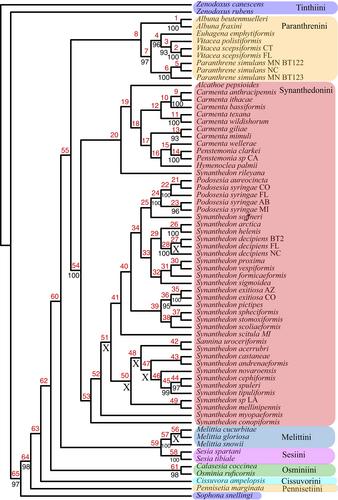北美净翅蛾(鳞翅目:绢翅蛾科)的多基因系统发育:为物种模仿复合体的未来进化研究奠定基础
IF 6.2
2区 生物学
Q1 EVOLUTIONARY BIOLOGY
引用次数: 1
摘要
Sesiids是一种以昼夜活动为主的多样化蛾类,其中许多是模仿膜翅目的Batesian。然而,人们对它们的多样性和关系知之甚少。一项对48个北美芝麻属物种的多基因系统发育分析证实了传统的分类学部落等级,证明了Carmenta和Synanthedon与其他几个属的同源性,并最终在北美和欧洲群体内部和之间提供了最低限度的系统发育分辨率。每个基因的特征支持表明CAD基因和其他四个基因的系统发育信号不一致。然而,从随后的系统发育分析中删除CAD并没有实质性地改变最初的系统发育结果,也没有将Carmenta和Synanthedon恢复为相互单系,这表明它不会影响整个系统发育信号。使用通常在物种水平上为其他鳞翅目提供信息的基因缺乏分辨率,这表明Carmenta/Synanthedon的物种辐射速度惊人。该小组还展示了广泛的模仿策略和寄主植物的使用,这可能是未来研究的沃土。本文章由计算机程序翻译,如有差异,请以英文原文为准。

Multi-gene phylogeny of North American clear-winged moths (Lepidoptera: Sesiidae): a foundation for future evolutionary study of a speciose mimicry complex
Sesiids are a diverse group of predominantly diurnal moths, many of which are Batesian mimics of Hymenoptera. However, their diversity and relationships are poorly understood. A multi‐gene phylogenetic analysis of 48 North American sesiid species confirmed the traditional taxonomic tribal ranks, demonstrated the paraphyly of Carmenta and Synanthedon with respect to several other genera and ultimately provided minimal phylogenetic resolution within and between North American and European groups. Character support from each gene suggested inconsistency between the phylogenetic signal of the CAD gene and that of the other four genes. However, removal of CAD from subsequent phylogenetic analyses did not substantially change the initial phylogenetic results or return Carmenta and Synanthedon as reciprocally monophyletic, suggesting that it was not impacting the overall phylogenetic signal. The lack of resolution using genes that are typically informative at the species level for other lepidopterans suggests a surprisingly rapid radiation of species in Carmenta/Synanthedon. This group also exhibits a wide range of mimicry strategies and hostplant usage, which could be fertile ground for future study.
求助全文
通过发布文献求助,成功后即可免费获取论文全文。
去求助
来源期刊

Cladistics
生物-进化生物学
CiteScore
8.60
自引率
5.60%
发文量
34
期刊介绍:
Cladistics publishes high quality research papers on systematics, encouraging debate on all aspects of the field, from philosophy, theory and methodology to empirical studies and applications in biogeography, coevolution, conservation biology, ontogeny, genomics and paleontology.
Cladistics is read by scientists working in the research fields of evolution, systematics and integrative biology and enjoys a consistently high position in the ISI® rankings for evolutionary biology.
 求助内容:
求助内容: 应助结果提醒方式:
应助结果提醒方式:


